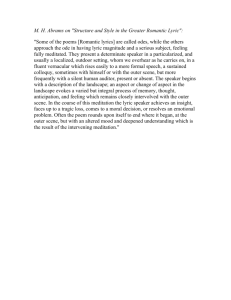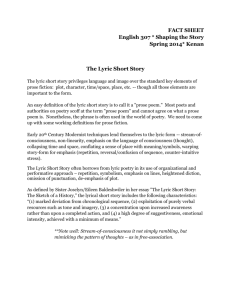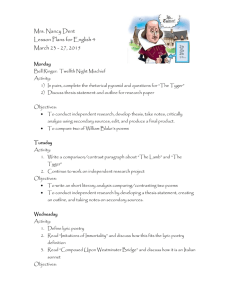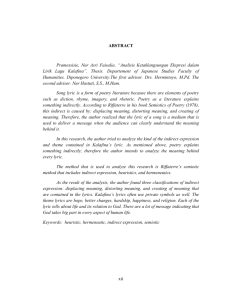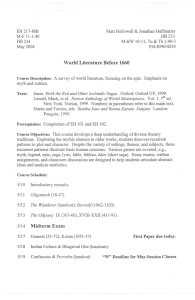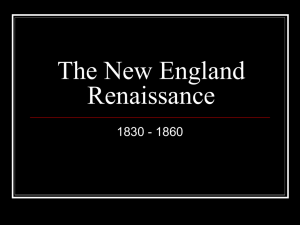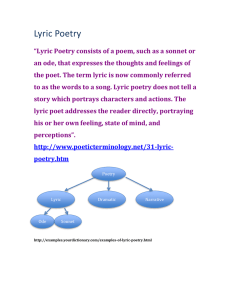[Review of the books
advertisement
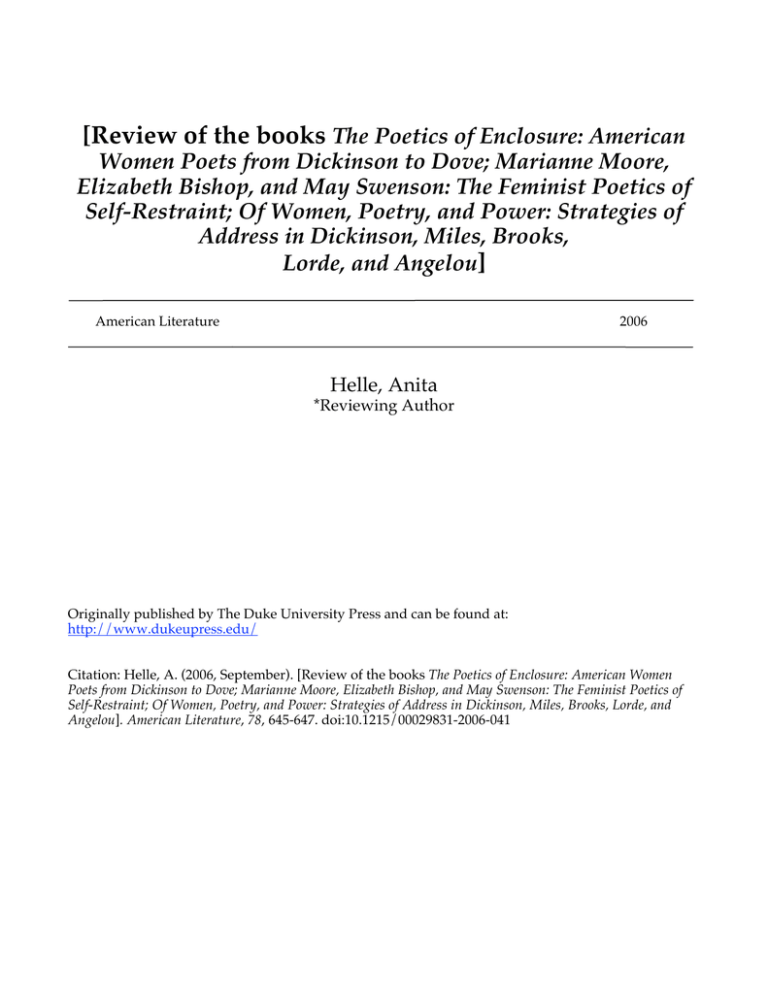
[Review of the books The Poetics of Enclosure: American Women Poets from Dickinson to Dove; Marianne Moore, Elizabeth Bishop, and May Swenson: The Feminist Poetics of Self-Restraint; Of Women, Poetry, and Power: Strategies of Address in Dickinson, Miles, Brooks, Lorde, and Angelou] American Literature 2006 Helle, Anita *Reviewing Author Originally published by The Duke University Press and can be found at: http://www.dukeupress.edu/ Citation: Helle, A. (2006, September). [Review of the books The Poetics of Enclosure: American Women Poets from Dickinson to Dove; Marianne Moore, Elizabeth Bishop, and May Swenson: The Feminist Poetics of Self-Restraint; Of Women, Poetry, and Power: Strategies of Address in Dickinson, Miles, Brooks, Lorde, and Angelou]. American Literature, 78, 645-647. doi:10.1215/00029831-2006-041 Book Reviews 645 subject, they are organized around three key points. The first two chapters provide readings of Marlon Rigg’s film Black Is . . . Black Ain’t and of popular and literary texts that both denigrate and appropriate queerness as the grounds of authenticating black masculinity. These chapters focus on how discourses of racial authenticity operate through forms of racial and sexual appropriation. Chapters 3 and 4 study tropes of domesticity and kinship as sites of mediation, exchange, and subversion in everyday black racial performance, discussing how family and the black mother, especially, are resignified in black gay vernacular culture, and how racist derogations of black maternity, such as the mammy stereotype, provide a grammar for everyday forms of subversion and tactical dissimulation. In the final chapters, Johnson analyzes his multiple roles as ethnographer, teacher, and performer with an Australian gospel group, and his experiences teaching African American literature through performance, where the university classroom and the student-teacher relationship serve as a dynamic staging ground for further study. Eden Osucha, Duke University DOI 10.1215/00029831-2006-040 The Poetics of Enclosure: American Women Poets from Dickinson to Dove. By Lesley Wheeler. Knoxville: Univ. of Tennessee Press. 2002. x, 2001 pp. $27.00. Marianne Moore, Elizabeth Bishop, and May Swenson: The Feminist Poetics of SelfRestraint. By Kirstin Hotelling Zona. Ann Arbor: Univ. of Michigan Press. 2002. xi, 187 pp. $55.00. Of Women, Poetry, and Power: Strategies of Address in Dickinson, Miles, Brooks, Lorde, and Angelou. By Zofia Burr. Champaign: Univ. of Illinois Press. 2002. xii, 232 pp. $39.95. In Lyric Interventions (2003), Linda Kinnahan summarizes twenty years of feminist poetry criticism by observing that gender now ‘‘comes with the territory’’ of lyric utterance. Just which contestants and which elements should be considered foundational to an understanding of lyric’s gender inflections and how the social and performative aspects of gender enter in have been debated for some time. These studies rescramble contestants who have been central or marginal to a canon of women poets, seeking to revise feminism’s assumptions about silence, restraint, reticence, reserve, and self-protectiveness. All three studies explore interlocking questions and concerns: How has the association with closed form and confinement been too narrowly construed in postromantic lyric? Can nineteenth-century models of domestic privacy serve as sufficient models for the poetic complexity of openness and enclosure across modernist generations? In undermining the univocality of silence and restraint, 646 American Literature each of these books offers compelling evidence for reconsidering what we expect from gendered approaches to lyric. Lesley Wheeler’s The Poetics of Enclosure takes the broadest approach (and not always with focus) to the relationship between enclosure and openness, aiming to outline the ‘‘history of a strategy’’ variously deployed by Emily Dickinson, Marianne Moore, H.D., Gwendolyn Brooks, Elizabeth Bishop, and Rita Dove (14). That resting too much on Dickinson’s ‘‘confine-conscious’’ lyricism as a bridge to twentieth-century poetry has become a problem is partially, but not fully, comprehended in the author’s insistence on ‘‘stretching’’ the notion of enclosure to encompass contradictory and paradoxically generative features, including Dickinson’s experimental interplay of form and content (14). Wheeler also argues that Rita Dove, read through Dickinson, sets in motion a revision of earlier feminist critical perspective, seeking not so much to escape as to explore the ‘‘paradoxes of privacy.’’ Given that Wheeler generalizes easily across many territories, these largely imagistic figurations of lyric ‘‘shelter’’ appear almost everywhere we look—in domestic architecture (closets, parlors, tombs), anthropomorphized versions of ‘‘shelter’’ in nature (shells, armor, raiment), and in constraints of urban settings (backyards and, for Gwendolyn Brooks, kitchenettes). This is not primarily a materialist or a historicized reading so much as an extended thematics of enclosure and its contradictions. Despite that limitation, startling and useful moments come in the productive juxtaposition of the homely and the strange, in a reading of Elizabeth Bishop’s unsettled locations and inscrutable houses against those of Rita Dove: here those binaries of outer-inner and public-private, an inherited feature of the opposition of enclosure to openness, finally more fully collapse to suggest ‘‘multivocal and discontinuous lyric subjects . . . meddling with devices of privacy and inwardness’’ (142). Whereas The Poetics of Enclosure approaches tensions between freedom and constraint in terms of domestic space and maternal influence, Kirstin Hotelling Zona’s study sets out to expand the strategic possibilities of self-restraint in relation to feminist consciousness and performative political claims. Arguing that the inclusion of Marianne Moore, Elizabeth Bishop, and May Swenson in a feminist canon has come at the cost of ignoring the productive possibilities of reserve itself for feminist ‘‘repossession,’’ Zona charts a different methodology, epistemology, and set of assumptions for the problematics of restraint and reserve. This amalgam of archival materials and the methodology of pairing poets, drawing from published and unpublished correspondence, adds complexity to the possibilities of the performative. In ‘‘answering’’ one another, it is clear that reserve takes on different, often reflexive and situational meanings that are beside the point of sexual ‘‘frankness’’ or ‘‘detail’’; the point about poetry as a ‘‘call to relationship,’’ through lyric identifications on elemental yet often mutable terms, is often reinforced through this method. Zona joins a number of critics who understand that poets espousing feminist attitudes may surely depart from confessional and autobiographi- Book Reviews 647 cal practices in their modes of expression and restraint; the more difficult case is demonstrating how such strategic and reflexive uses of reserve constitute a claim on the political. Demonstrating that cultivating the tension between authenticity, disguise, and restraint is performative rather than characterological, Zona’s chapter on May Swenson appropriately demonstrates the links between the subjectivity of lyric and the performance of gendered embodiment in Swenson’s one-act plays. Given that the debates about gender and lyric so often confuse or conflate feminist political consciousness with gendered poetic practice without historicizing these tensions, I found myself returning to Zofia Burr’s Of Women, Poetry, and Power for a refreshing departure from that tendency. There is a case to be made, as Burr’s introductory chapter argues, for a history of expressive discourse on lyric as ‘‘oppressive’’ and ‘‘suffocating’’ in its effect on criticism of women poets in the last half of the century, for in reading the gendered lyric largely through a construction of lyric inwardness, critics have neglected lyric’s capacity for joining rhetorical occasions and performative roles in more concrete innovations of address and crafted political statement. Ironically, given that early feminist readings of lyric in the 1970s and 1980s rested on the assumption of lyric voice as the intersection of speech and trope, this study, emphasizing the ‘‘outwardness’’ rather than the ‘‘inwardness’’ of lyric, appears to have returned to that terrain. If so, we have come full circle from a different direction, now more open to the role of reception in comprehending the coded strategies, silences, and reserves of lyric (and feminine) utterances, and more open, too, to conventions of lyric that overlap communicative utterance or in other ways depart from the conventional parameters of lyric utterance as closed off from rhetorical culture. Burr’s study breaks new ground by exploding the West Coast as well as the East Coast canons of twentieth-century women poets. The chapter on Josephine Miles incorporates and updates the problems associated with Miles’s reception by showing how critical responses toward Miles’s physical disability might be best understood against the backdrop of her continual enshrinement, effacement, or rehabilitation as a failed or successful Dickinsonian poet. Burr’s use of Miles’s scrapbook and archival materials at the University of California, Berkeley, strengthens a case already made by Lisa Steinman and others that Miles’s career was not shaped by conventional lyric practice but by a different definition of poetry as a public idiom. With its emphasis on reception and address as a way to return to the challenges and divisions associated with feminist critique of gendered lyric, Burr’s study takes the deepest cut of all in historicizing the terms woman and poet. All along, part of the problem has been not politics—or feminism—but the narrowness or expansiveness accorded the lyric. Anita Helle, Oregon State University DOI 10.1215/00029831-2006-041
